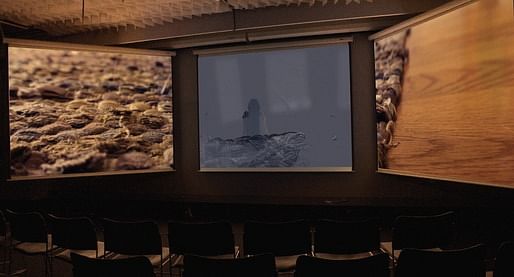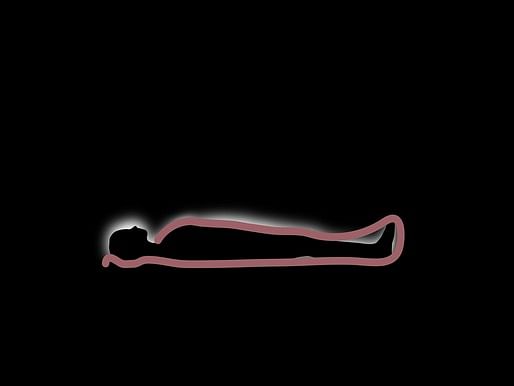
Hi Archinect,
Well, I'm very happy to say that I presented my thesis just over a week ago, and it went well. I gave the following very short preamble:
There’s a termite in the southern hemisphere that lives in a colony, that builds a mound, that acts as an external lung. The mound—which, after all, is a pile of dirt—manages gas exchange for all the termites in the colony. A single termite cannot live without either its or colony or its mound; for this reason, physiological ecologists such as J. Scott Turner have argued that the termite is socially, physiologically, and cognitively extended in a way that makes it impossible to say where the organism ends and where its environment begins.
As humans, our tools are more complex, but they’re also so inherent to our everyday lives that we often take them for granted.
For example: A person moves differently if they are wearing shoes or barefoot. Of course, the shoes we make depend on the surfaces we create to walk on, so there’s an immediate and physical reciprocity between bodily acts, our built environment, and the other artifacts we create.
We can also see this reciprocity over a longer time span. The biological anthropologist Richard Wrangham has argued that our evolution into Homo sapiens depended on our mastery of fire. That is, it depended on the digestive changes cooking brought to our anatomy and our use of time—but also the changes it brought to our social organization and our use of space. We normally think of biology as the more stable substrate on which culture is layered, but the influence runs both ways.
In this thesis, I’ve been interested in how we, as humans, are extended within our built environment. How we rely on our surroundings continually to draw out certain body states and behaviors from ourselves, and how this requires that we draw out certain qualities and conditions from our environment in turn. And how, like the termite, it’s impossible to say where the organism ends and where our environment begins. The project isn’t an attempt to produce or represent scientific findings; instead, my thesis is in the form of a kind of illustrated essay that aims to draw out these ideas in the kind of rich context in which architecture operates. It lasts 12 minutes and after it plays I look forward to discussing it with you.
And then I played the video, which was installed like this on three screens:


Sometimes the screens showed three different images, sometimes it showed a continuous image across all three screens, and sometimes it showed a hybrid. A smaller and compressed version of this video is posted here. I hope you enjoy--just bear in mind that it's not quite the same seeing the video on a laptop as in the immersive context of a large, triple projection with sound that fills the room.
I had the following stills posted in the room, and the great pleasure of having Michelle Addington, Elena Manferdini, Zynep Celik Alexander, Kiel Moe, Sanford Kwinter, and Faye Hays on my jury, as well as my advisors, Danielle Etzler and K Michael Hays. A great group of critics can really get you to see how the end result of the project at hand is really the beginning of the next project--and this group certainly did that. So I'm really grateful to all of them.








Thanks for reading!
Lian
This blog was most active from 2009-2013. Writing about my experiences and life at Harvard GSD started out as a way for me to process my experiences as an M.Arch.I student, and evolved into a record of the intellectual and cultural life of the Cambridge architecture (and to a lesser extent, design/technology) community, through live-blogs. These days, I work as a data storyteller (and blogger at Littldata.com) in San Francisco, and still post here once in a while.



4 Comments
marvelous.
why do you think so, ubu loca?
First, Congratulations.
The investigation into the interface/interdependence/relation between human and human-made is always intriguing. It seems like a topic that has not been looked at a ton lately (I know there are some people working on it), but it is interesting to see a more "painterly" approach to the investigation.
I would be interested to hear what the critics had to say. In particular, Michelle Addington. Seems like something she would dig. Who were your advisers?
Hey ubu, Matthew, thanks! Sorry for the belated reply.
Matthew: Michelle Addington basically (and correctly) noted that I didn't entirely make good on my claims, in that I more often and more obviously depicted architecture in a prosthetic function (the way the self extends itself by using the environment as a tool); and showed less about the ways in which our environment extends into us. (I sort of tried to get at that indirectly, through the scenes that aimed to evoke something about the phenomenology of an experience, or in depicting food and digestion, or by trying to provoke a response in the viewers themselves--but this was often implicit.) But she was also very intrigued by the techniques and was extremely supportive of this as an investigation.
My advisers were Danielle Etzler and K. Michael Hays. They were amazing. Long live!
Block this user
Are you sure you want to block this user and hide all related comments throughout the site?
Archinect
This is your first comment on Archinect. Your comment will be visible once approved.